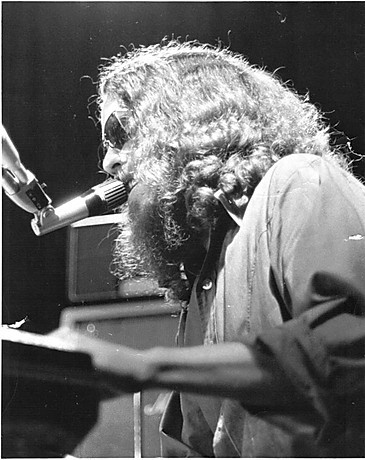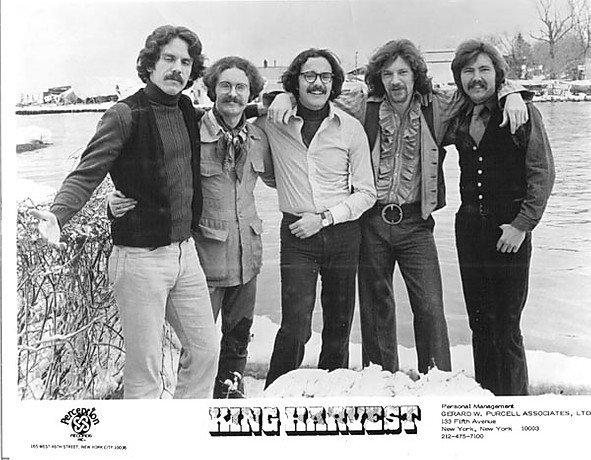Like many music enthusiasts, I was eagerly anticipating a concert weekend, a fantastic lineup featuring Pure Prairie League, Poco, and Orleans. The pandemic, however, had other plans, leaving concert halls empty and music lovers longing for live performances. In the anticipation of this show that never happened in May 2020, I found myself revisiting classic tunes, particularly drawn to Orleans’ rendition of “Dancing in the Moonlight,” a King Harvest gem. This led me down a rabbit hole of YouTube videos and comments, where, to my surprise, I stumbled upon a comment by Sherman Kelly himself, the songwriter behind “Dance In The Moonlight Song”.
Intrigued by the prospect of uncovering the story behind this timeless track – the kind of narrative that fuels my passion for music history and my work at ten-dance.com – I reached out to Sherman Kelly. To my delight, he agreed to share the incredible, and somewhat unbelievable, origin story of “Dancing in the Moonlight.”
 Sherman Kelly onstage in the 1970s.
Sherman Kelly onstage in the 1970s.
Sherman Kelly onstage in the 1970s. (Photo courtesy of Sherman Kelly)
From Paradise to Peril: The Dark Genesis of a Joyful Song
The genesis of “dance in the moonlight song” is far from the joyful imagery it evokes. In 1969, Sherman Kelly was managing a nightclub in St. Thomas, Virgin Islands. An ill-fated day trip to St. Croix on a rented yacht took a dramatic turn when Kelly succumbed to severe seasickness, a condition he was previously unaware of. Upon reaching St. Croix, while his companions sought dinner, Kelly and his girlfriend, still battling seasickness, decided to forgo food.
As evening approached, the sight of their yacht swaying in the harbor convinced the queasy couple to seek lodging ashore. However, Kelly’s wallet remained on the boat, leaving them penniless. They approached a local innkeeper, explaining their predicament and promising payment in the morning. The innkeeper’s unsettling proposition – accommodation in exchange for his girlfriend’s company – forced them to seek alternatives.
With no other options and under a beautiful starlit sky, Kelly’s girlfriend suggested they simply sleep on the beach. “And that’s all I remember very clearly,” Kelly recounted in our interview. This marked the beginning of a horrific ordeal.
 King Harvest in 1972.
King Harvest in 1972.
King Harvest in 1972. (Photo courtesy of Sherman Kelly)
An Alternate Reality Born from Trauma
What transpired next was a brutal assault. While sleeping on the beach, Kelly and his girlfriend were attacked by the notorious Fountain Valley Gang. Kelly was viciously beaten with baseball bats by five gang members, while his girlfriend was subjected to a horrific sexual assault. Miraculously, Kelly regained consciousness during the attack and fought back, his resistance and outcry startling the attackers and causing them to flee.
Severely injured and drifting in and out of consciousness, they managed to reach the only hospital on St. Croix. They were later believed to be among the early victims of this gang, infamous for a later massacre of tourists that devastated St. Croix’s tourism industry. Kelly’s condition was so critical that he overheard doctors doubting his survival. Yet, against the odds, he pulled through, spending days in the St. Croix hospital before returning to New York for further treatment to repair his fractured face and other injuries.
Back home in Ithaca, New York, and enduring a painful recovery, Kelly turned to songwriting. It was during this convalescent period that the lyrics for “dance in the moonlight song” began to take shape. “I envisioned an alternate reality, the dream of a peaceful and joyous celebration of life,” Kelly explained. “It was just me imagining a better world than the one I had just experienced in St. Croix.” From unspeakable trauma emerged a song of escapism and joy, a testament to the resilience of the human spirit.
 Boffalongo, circa 1970.
Boffalongo, circa 1970.
Boffalongo, circa 1970. (Photo courtesy of Sherman Kelly)
From Boffalongo to King Harvest: The Song’s Journey to the Charts
Initially, Kelly’s band Boffalongo, which included his brother Wells Kelly and future Orleans member Larry Hoppen, recorded “Dancing in the Moonlight” for their 1970 album “Beyond Your Head.” However, Sherman Kelly is self-deprecating about his vocal performance on this version, citing a disastrous studio experience involving cocaine. Despite this, the Boffalongo version gained regional popularity. Another 1970 recording by High Broom failed to chart.
The song’s breakthrough came when Wells Kelly joined King Harvest, featuring former Boffalongo member Doc Robinson. Wells introduced “Dancing in the Moonlight” to the band, and their 1972 recording, with Robinson on lead vocals, became a hit, reaching No. 13 on the Billboard Hot 100. King Harvest invited Sherman Kelly to tour with them, where he provided harmonies while Robinson handled the lead vocals on his song. Despite enjoying the initial excitement of touring, Kelly found the lifestyle unsustainable and left after one tour.
Enduring Moonlight: Orleans, Toploader, and Beyond
Wells Kelly later joined forces with John Hall and Larry Hoppen to form Orleans. Orleans also recorded “Dancing in the Moonlight,” further cementing the song’s place in music history. The song experienced a resurgence in popularity in 2000 when Toploader’s cover became an international hit. “Dance in the moonlight song” has also been featured in numerous films, television shows, and video games, proving its enduring appeal across generations.
 Sherman Kelly today.
Sherman Kelly today.
Sherman Kelly today. (Photo courtesy of Sherman Kelly)
Sherman Kelly’s life took many turns after the initial success of “dance in the moonlight song.” He pursued higher education, earning a master’s degree in social work and psychotherapy, and worked as a psychotherapist for many years. However, music remained a part of his life. In 2008, he released an album featuring collaborations with his late brother Wells.
The story of “Dancing in the Moonlight” is a remarkable journey from a horrific real-life event to a song that embodies joy and escapism. It’s a testament to Sherman Kelly’s songwriting talent and the power of music to transform personal trauma into something beautiful and enduring, a song that continues to invite listeners to “dance in the moonlight” decades later.
